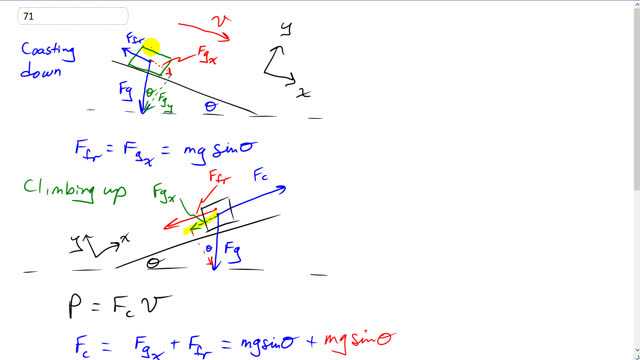
A bicyclist coasts down a hill at a steady speed of 4.0 m/s. Assuming a total mass of 75 kg (bicycle plus rider), what must be the cyclist’s power output to climb the same hill at the same speed?

In order to watch this solution you need to have a subscription.
This is Giancoli Answers with Mr. Dychko. The first thing we'll look at is this scenario where the cyclist is coasting down the hill so that her velocity is directed down there. We can see that the since they are going at constant speed, the friction force, directed up the hill, against the velocity must be equal to the component of gravity that's directed down the hill, F gx. And so that gives us this formula that force of friction has to equal mg times sin theta because F gx is the opposite leg of this triangle here and so we'll use sin to calculate it. So that's the friction force that we are going to use in the next part of the question, which is when the cyclist is going back up the hill. The friction force would be the same because the cyclist has the same speed, the air drag will be the same and it's the same tyres in contact with the same road surface, you know, it hasn't started raining yet I'm assuming so the friction force will be the same. And so that was the value of looking at this scenario was to figure out what that friction force would be for the second scenario. So we have the power exerted by the cyclist will be the cyclist's force times its velocity and the force is gonna have to equal the component of gravity, directed down the slope, F gx, plus the force of friction. And as it turns out, these arrows should be the same length; this red one and this dotted green one because they are both ng sin theta And so here's the x-component of gravity, mg sin theta, plus the friction force that we figured out in the first part of the question, also mg sin theta. So the force of the cyclist is 2mg sin theta. So, we plug that in for the force and multiply by the velocity and we get that the power output of the cyclist has to be 2 times 75 kilograms times 9.8 newtons per kilogram times sin of 6 degrees times 4 meters per second which is about 610 watts.